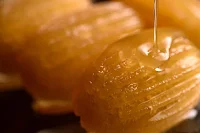The first time I saw tulumba in a Turkish patisserie they reminded me of churros from Madrid. In fact, its shape is as if we cut the churros to make a mini version of them and bathe them in syrup. And the truth is that tulumba are not that different from churros.
 |
| Spanish or Mexican (depend on where you are) churros |
As in the case of churros, they are made with a kind of choux pastry that is passed through a pastry bag to fry them and then bathe them in syrup as is done with baklava. The pasta itself is not too sweet, to say nothing like the churros, but the syrup is the sweetest you've ever tasted.
You can find tulumba in many Eastern European countries but especially in Greece and Turkey where it is sometimes called tulumba tatlisi (literally sweet bombs).
INGREDIENTS :
1. For the syrup:
- 3 cups of white sugar
- 2 cups of water
- 1 teaspoon lemon juice
2. For the pasta:
- 400 grams (14 oz) of pastry flour
- 4 eggs
- 2 cups of water
- 1 cup of milk
- 1/3 cup of vegetable oil or melted butter
- 1 spoon of sugar
- 1 tablespoon of vanilla extract (yes, you read that correctly, a tablespoon, they are very "vanilla")
- 1 tablespoon of white wine vinegar (or apple vinegar)
- 1 pinch of salt
- Sunflower or corn or canola oil for frying (enough to have three inches deep in the pan where the tulumba will be fried)
(just remind you, each cup of 200 ml, for metric users)
First we make the syrup. To do this, add two cups of water to a casserole and add the sugar and lemon juice over low heat so that it does not crystallize. With a wooden spoon we are stirring until the sugar dissolves and the syrup acquires the thread point (that is, the syrup thickens and when the spoon is lifted a thread is formed between it and the surface of the syrup). Remove from heat and let cool.
Now we are going to make the pasta. To do this, pour the water, milk, vegetable oil, and a tablespoon of sugar, in addition to the tip of salt, in a saucepan over medium heat. Bring to a boil without stopping stirring. As soon as it boils, we immediately remove it from the heat and add all the sifted flour at once to prevent lumps from forming (I usually use a fine strainer).
Stir well so that all the flour is incorporated - one minute will be more than enough - and then return the saucepan to the heat, this time low heat.
With the spoon you stir the dough trying not to burn. The reason for doing this is to remove the excess moisture, although this procedure should not exceed one minute.
Then we remove the casserole from the heat and pour the dough into a bowl and add the 4 eggs and the tablespoon of vinegar as well as the vanilla. It is advisable to do it with a mixer - many kitchen robots incorporate it - but if you don't have it, just work the dough with the wooden spoon until the eggs are absorbed.
The following is already easy since since it does not have yeast, you do not have to wait a while for the dough to rise. We add it to a pastry bag with the typical nozzle for making churros or whipped cream decorations. We heat the vegetable oil to the point of smoke and carefully we make the small tulumba (1 to 2 cm long, half or one inch) directly on the oil, frying them until golden brown.
Once fried - watch out, don't burn them! - They are left on absorbent paper to collect the excess oil and then soaked in the syrup.
Let them cool and ready to eat.
Delicious sweets that will put you immediately in the East.



